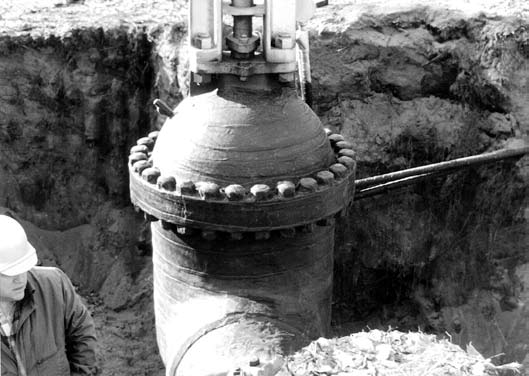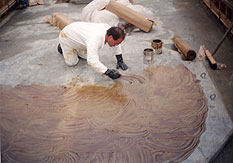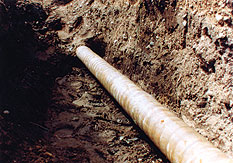Trenton Wax Tape, Primers, Outerwraps | Corrosion Prevention
Since 1949, the Trenton Corporation has manufactured wax-based corrosion prevention products that provide long-lasting anti-corrosion protection for pipelines. We carry Trenton Wax Tape systems for aboveground and underground applications. Additionally, we sell hot-applied and cold-applied waxes, outerwraps to provide additional resistance, and casing filling for cable casings and pipelines.
Wax-Tape Anti-Corrosion Wraps
 Trenton Corporation’s anti-corrosion tape protects pipelines against corrosion better than paint and does not require the surface preparation demanded by paint or epoxies. The wax tape uses thick microcrystalline waxes and plasticizers to conform to irregularly shaped surfaces and fittings. The tape is compatible with many materials, including steel, ductile iron, and PVC. Trenton Wax-Tape® wraps are non-firming; in other words, they do not dry rock hard.
Trenton Corporation’s anti-corrosion tape protects pipelines against corrosion better than paint and does not require the surface preparation demanded by paint or epoxies. The wax tape uses thick microcrystalline waxes and plasticizers to conform to irregularly shaped surfaces and fittings. The tape is compatible with many materials, including steel, ductile iron, and PVC. Trenton Wax-Tape® wraps are non-firming; in other words, they do not dry rock hard.
There are four wax tape products worthy of mention:
-
- Wax Tape #1 prevents corrosion of metal pipe and fittings that will be backfilled and buried below ground. The blend of wax, plasticizer, and corrosion inhibitor forms a tape wrapper and remains pliable, and supports cathodic protection.
- Wax Tape #2 prevents corrosion on both the aboveground and belowground metal pipe and fittings. This product is easy to apply and requires minimal surface preparation and no special equipment. When blasting or painting is impractical, #2 works well. It is UV and weather-resistant and does not require an additional outerwrap or outercoat.
- Wax Tape HT-3000 prevents corrosion on both aboveground and belowground high-temperature applications up to 230°F (110°C)
-
- Riser Kits are ready-to-use wax coatings that protect residential risers from corrosion. The kits are also for meter sets, CAD welds (and other CP connections), small fittings and fixtures, Propane, and LNG connections.
Primers & Other
A Trenton primer is required for the wax-tape system to be effective. The primer penetrates the exterior rust and prepares the surface for the wax-tape application. Only wire brushes are needed to prepare the surface.
 Wax Tape Primer (Brown) is a surface conditioner for aboveground and belowground metal surfaces before applying Trenton Wax-Tape® #1 and #2 wraps.
Wax Tape Primer (Brown) is a surface conditioner for aboveground and belowground metal surfaces before applying Trenton Wax-Tape® #1 and #2 wraps.- Wax Tape Primer (White) is a surface conditioner for above-ground and below-ground metal surfaces before the application of Trenton Wax Tapes.
- Temcoat™ Primer is an anti-corrosion product for aboveground, belowground, and underwater metal surfaces.
- Temcoat 3000 Primer is a high-temperature wax-based coating that will not melt and can be applied at temperatures from 0-230°F.
- Fill-Pro™ PM-GP Profiling Mastic establishes smooth profiles over irregularly shaped fittings (flanges and valves). Use in combination with Trenton Wax Tapes and primers to create an effective exterior corrosion coating for pipe and other metal substrates.
- Fill-Putty™ Profiling Mastic is an anticorrosive moldable filler material used to smooth the contours of irregular fittings and surfaces. Use it before overwrapping with wax-tapes.
- Patch-Pad® Exothermic Weld Protector is a coating for cathodic protection system connections and small applications, protecting. The product conforms to safeguard a variety of profiles and most connection configurations.
Innercoat
The combination of Innercoat® Hot-Applied Wax and Guard-Wrap™ prevents corrosion of belowground metal structures.
Outerwraps
When a wax tape wrap application requires additional mechanical protection, Trenton has a full line of outer wraps (or overwraps) to augment the tape.
 MCO™ Outerwrap is for aboveground or belowground as a “hard shell” mechanical protective wrap over Trenton anticorrosion wraps.
MCO™ Outerwrap is for aboveground or belowground as a “hard shell” mechanical protective wrap over Trenton anticorrosion wraps.- PVC Outerwrap offers an economical approach to applications requiring additional mechanical protection due to severe spoil stress or mechanical impingement. Simply spiral-wrap, with an overlap, over the coating. No special tools are needed.
- Guard-Wrap Outerwrap is a protective wrapper over the Innercoat that provides mechanical strength against backfill stress and contributes an additional dielectric barrier.
- Poly-Ply™ Outerwrap is a plastic wrapper over cold-applied Temcoat coating on a straight pipe and irregular metal surfaces, such as T’s and couplings.
- Glas-Wrap™ is an overwrap for Trenton’s #1 Wax Tape for additional protection against light backfill.
Casing Filling
- Fill-Coat® #1 is a full-service, hot-installed casing filler for pipeline casings. A Trenton truck delivers the Fill-Coat to the job site. Fill-Coat #1 displaces water from the casing to prevent new water from re-entering, thereby preventing further corrosion.
- Fill-Coat #2 is a cold-applied wax casing filler delivered in 55-gallon drums. The wax-based corrosion preventative compound fills the pipeline casing annulus, designed explicitly for cold installation.
- Fill-Coat #6 is a cold-installed/high-temperature petroleum-based casing filler used to fill aboveground cased pipe, such as the annulus of bridge abutment casings in gas distribution. It averts corrosion by filling the void in the casing annulus, preventing water from entering the gas-filled casing.
- Pre-Con® Casing Corrosion Inhibitor is a liquid casing water conditioner for pipeline casings.
- Short-Stop™ End Insulator is made of neoprene rubber and installed in casing ends. Short‑Stop has dielectric properties and is resistant to oil, ozone, water, and chemicals.
- Seal-Wrap™ End Seal is a casing end-seal wrapper comprising heavy, woven fiberglass coated with a high-dielectric-strength butyl mastic wrapped around the end of the casing and on carrier pipe.
Watch Application Procedures
Trenton Corporation Distributors
Linc Energy Systems is the stocking distributor for Trenton Systems. We ship from our conveniently located warehouse in Lakewood, Colorado.
Corrosion Prevention Articles of Interest:
Effective corrosion prevention methods for pipelines
Explore techniques used in pipeline anti-corrosion programs, including wax tape, cathodic protection, coatings and linings, corrosion inhibitors, and materials.